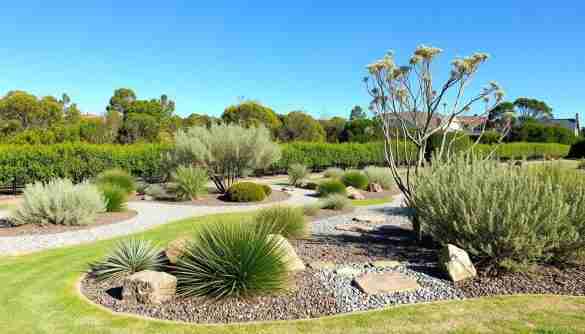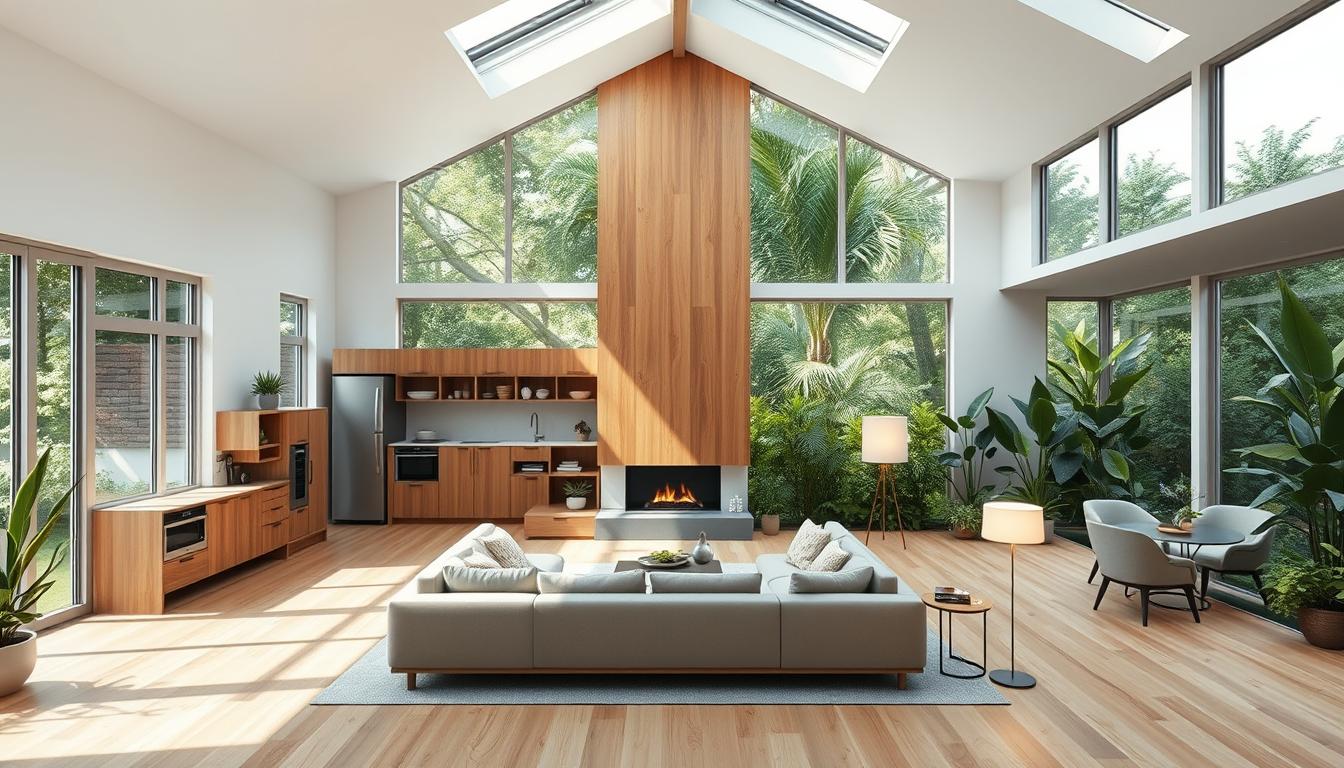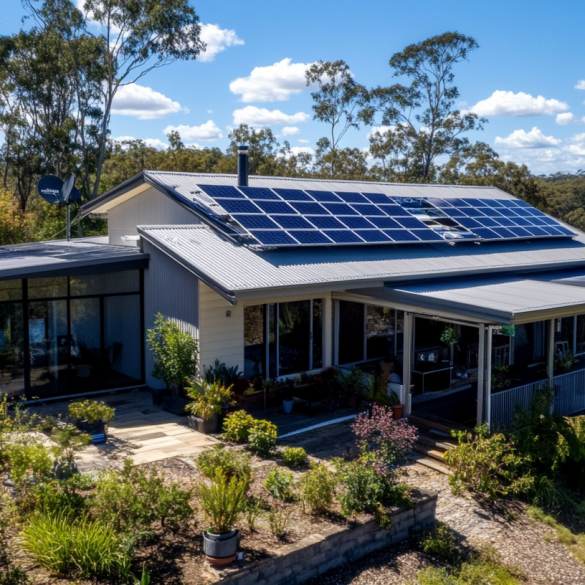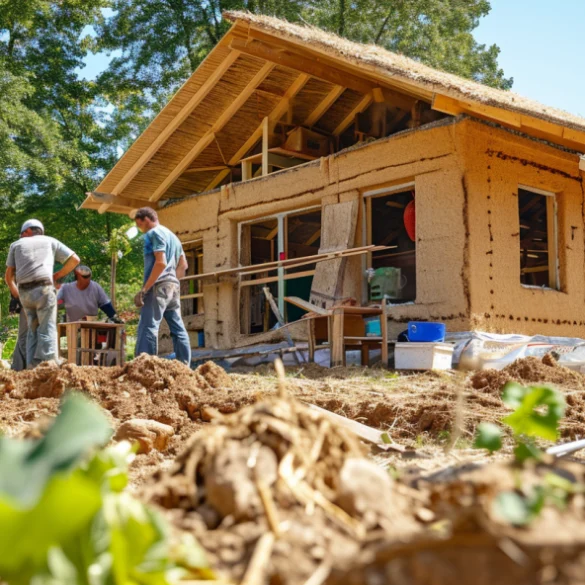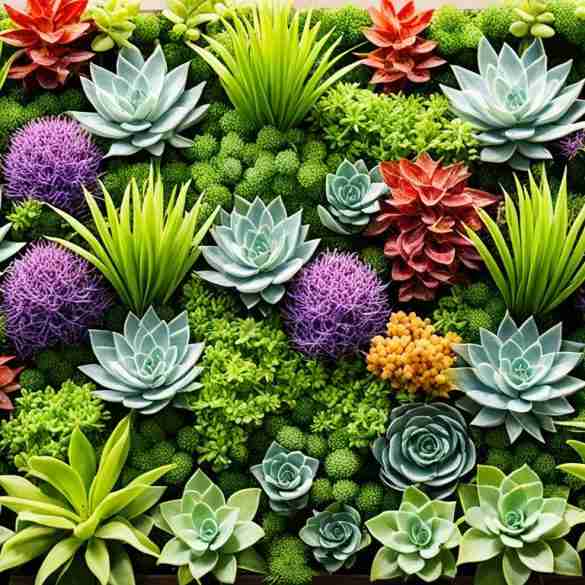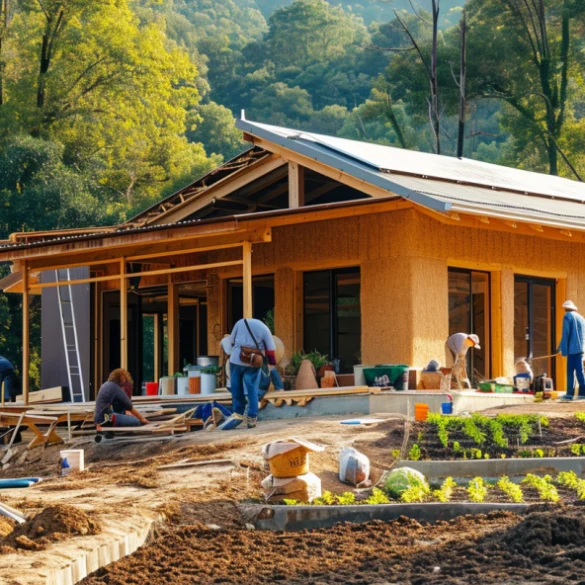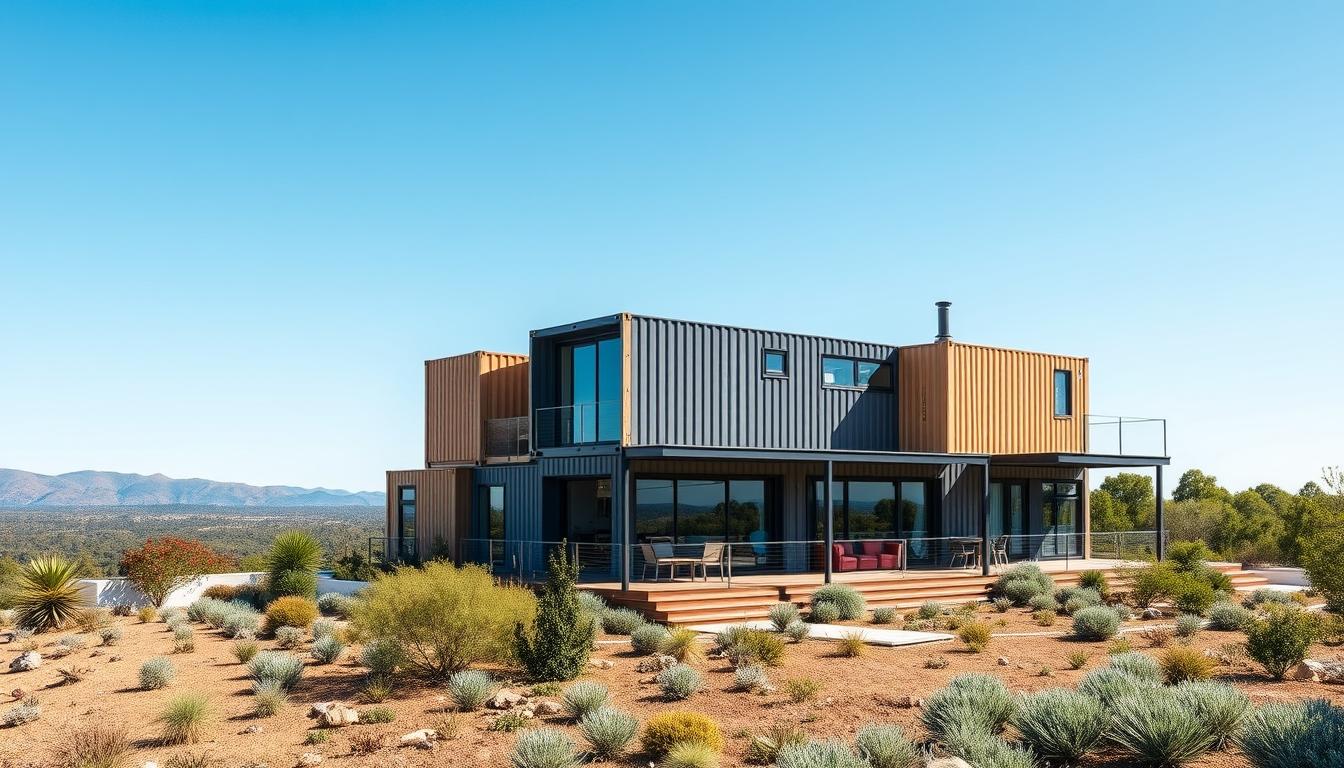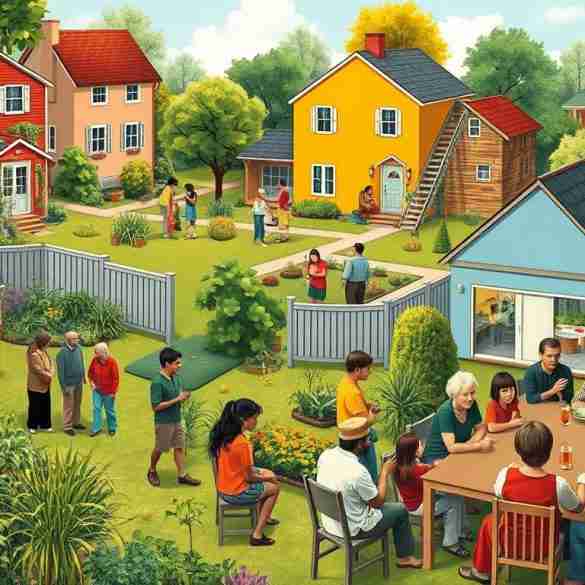Last summer, Australia saw one of its worst bushfire seasons. Over 12 million hectares of land were burnt. Ember attack caused over 80% of house losses to bushfires. As a homeowner in a bushfire-prone area, you can protect your property. This can be done through fire-smart landscaping and bushfire-resistant design.
Designing a fire-smart garden means thinking about layout and plant choice. This helps reduce flames, radiant heat, and embers on your home. The Victorian Country Fire Authority (CFA) suggests creating defendable space and removing flammable objects.
They also recommend breaking up fuel continuity and choosing the right trees. By using fire-resistant plants and smart landscaping, you can make your outdoor space more resilient. This helps protect your home during a bushfire.
Key Takeaways
- Create defendable space around your home by reducing fuel loads and strategically placing plants
- Choose fire-resistant native plants like saltbush and pigface, and avoid highly flammable species near your home
- Maintain high moisture content in plants through regular watering to reduce their flammability
- Use non-combustible surfaces and hardscaping features to create firebreaks and reduce fire risk
- Regularly maintain your landscaping by pruning, removing dead vegetation, and disposing of garden waste properly
What is Bushfire-Resistant Landscaping?
Bushfire-resistant landscaping aims to lower the risk of bushfires. In Australia, especially in Victoria, it’s key to protect homes. By placing plants and trees wisely, you can make a safe area around your house.
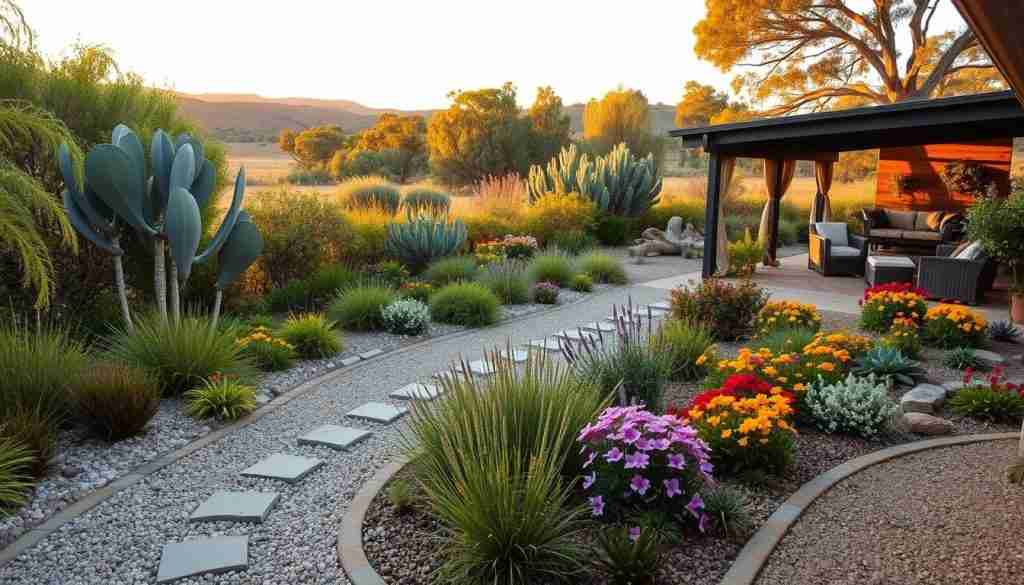
How Landscaping Affects Bushfire Risk
Your landscape design can greatly affect bushfire risk. Some plants can help stop fires, while others can spread them. Plants with lots of moisture and dense leaves are safer.
Weather and topography also matter. Fire moves faster uphill and burns better in hot, windy conditions. Knowing this helps in designing a fire-safe garden.
Landscaping Standards in Bushfire-Prone Areas
In Victoria, there are rules for landscaping in fire-prone areas. These rules help protect homes from fires. The Country Fire Authority (CFA) suggests:
- Creating defendable space
- Removing flammable objects
- Breaking up fuel continuity
- Carefully selecting, locating, and maintaining trees
- Using groundcovers with low flammability and low-growing succulents
- Avoiding planting shrubs under trees
Integrating Landscaping with Bushfire Building Codes
Landscaping should match building codes in high-risk areas. In Victoria, there’s a Bushfire Management Overlay for such areas. Make sure your garden meets local rules.
Using fire-resistant plants and creating safe spaces can help. But, remember, a garden alone isn’t enough. You also need to follow building codes and have a Bushfire Survival Plan.
Choosing Fire-Resistant Plants for Landscaping
When you landscape in areas prone to bushfires, picking fire-resistant plants is key. These plants are less likely to catch fire and spread flames. They help protect your home and property.
Characteristics of Fire-Resistant Plants
Fire-resistant plants have special traits. They include:
- High moisture content in leaves and stems
- Low levels of volatile oils and resins
- Ability to shed dead leaves and twigs quickly
- Thick, fleshy leaves that can absorb heat
- Deep root systems that retain moisture
These plants are less likely to catch fire. They can also slow down fire spread by absorbing heat and trapping embers.
Recommended Fire-Resistant Native Plants
Australia has many native plants that can handle bushfires. Some good ones include:
| Plant Name | Species | Characteristics |
|---|---|---|
| Saltbush | Atriplex and Rhagodia species | High salt content, low flammability |
| Pigface | Carpobrotus glaucescens | Succulent leaves, high moisture content |
| Tuckeroo | Cupaniopsis anacardioides | Dense canopy, low flammability |
| Blueberry Ash | Elaeocarpus reticulatus | Thick, leathery leaves, high moisture content |
| Native Frangipani | Hymenosporum flavum | Fleshy leaves, low flammability |
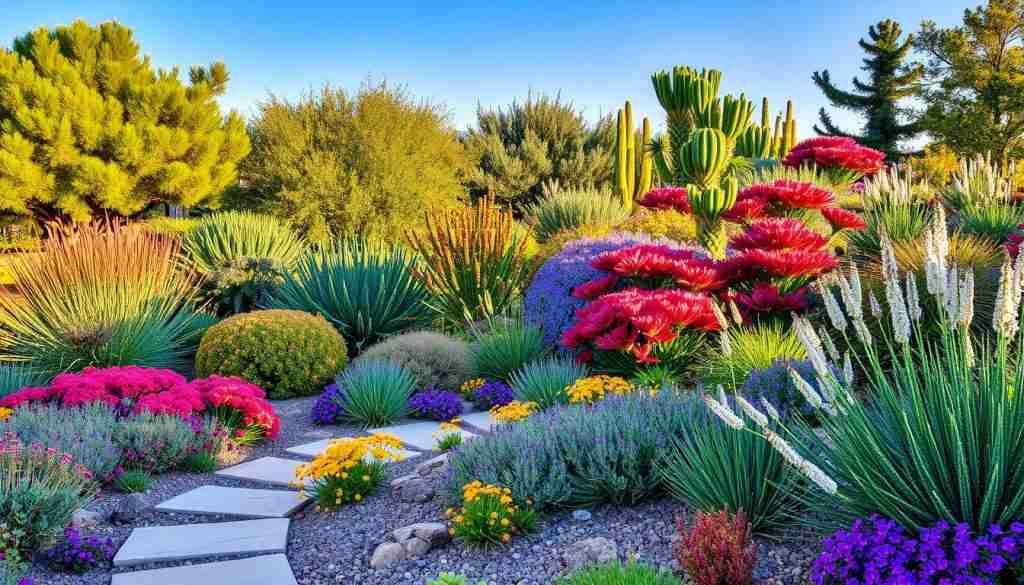
Some non-native plants, like Magnolia grandiflora from the southeastern United States, can also be fire-resistant. They are good for Australian gardens.
Avoiding Fire-Prone Vegetation
It’s also important to avoid plants that catch fire easily. Some plants to avoid include:
- Eucalyptus and tea trees (Leptospermum species)
- Lilly pillies (Syzygium species)
- Some wattle species (Acacia)
- Conifers with volatile oils and resins
These plants can fuel fires. By not having them near your home, you can lower the risk of fire damage.
“Pittosporum undulatum, previously considered fire retardant, has been found to be flammable. This shift in classification underlines the importance of staying updated on plant safety information.” – Sustainable Home Magazine
Strategic Plant Placement for Fire Safety
Choosing the right plants is just part of the solution. Where you place them is also crucial. Here are some tips:
- Use fire-resistant ground covers to slow the travel of fire across your property
- Separate the litter layer from tree canopies to prevent fire from climbing into the treetops
- Create green buffers around your home using fire-retardant vegetation
- Avoid planting fire-prone species near windows, doors, and other vulnerable areas of your home
By picking and placing fire-resistant plants wisely, you can make your landscape safer. It will also look beautiful.
Creating Defensible Space Around the Home
In areas prone to bushfires, making a defensible space around your home is key. This space helps protect your property and keeps your family safe. It’s an area where plants and other flammable stuff are managed to slow fire spread.
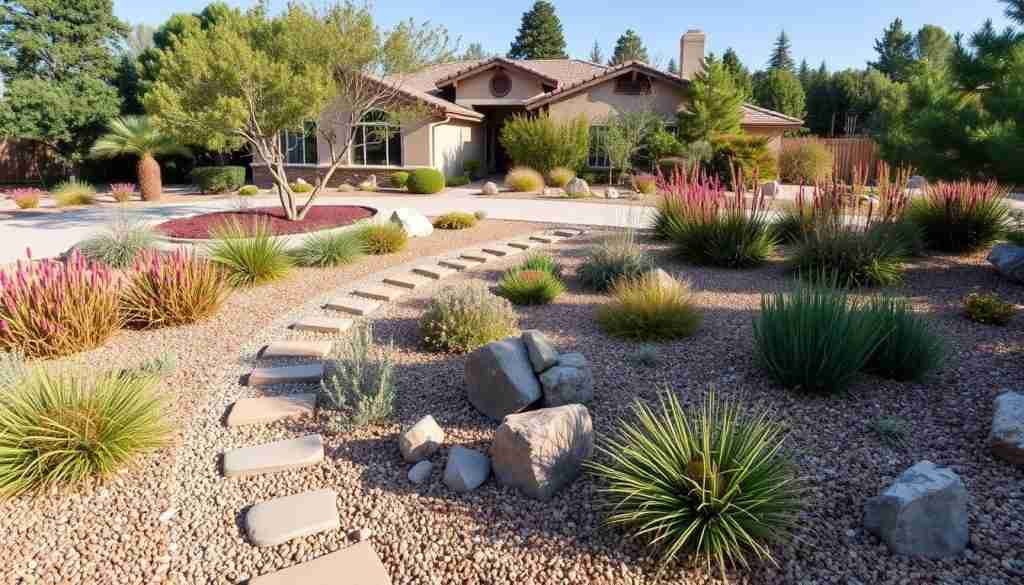
What is Defensible Space?
Defensible space is a managed area around your home to lower bushfire damage risk. It acts as a barrier to slow fire spread. This gives firefighters a safer area to work and helps your home survive a bushfire.
Zones of Defensible Space
Defensible space is divided into three zones:
- Zone 1: Closest to your home (10-30 meters). Keep it free of flammable stuff and debris.
- Zone 2: 30-50 meters from your home. It can have some low-flammability plants. Keep it tidy by pruning and removing dead stuff.
- Zone 3: Furthest from your home (50-100 meters). It can have more plants but still needs management. Thin trees and remove undergrowth.
Planting in Defensible Zones
When landscaping, pick fire-resistant plants and keep them in good shape. Here are some tips:
- Choose native, fire-resistant plants that fit your local climate and soil.
- Space plants right to avoid fire paths.
- Avoid planting under trees or near buildings, as they’re fire-prone.
- Regularly remove dead plants, branches, and leaf litter.
Maintaining Defensible Space Throughout the Year
Keeping your defensible space up is a year-round job. Regular care is key to keep your space effective against bushfires. Some important tasks include:
- Water plants well, especially in dry times, to lower flammability.
- Prune trees and shrubs often to keep them healthy and shape them.
- Mow grass and remove weeds to keep them short and fire-resistant.
- Clear gutters, roofs, and outdoor areas of debris that can ignite easily.
“Creating and maintaining defensible space is crucial to protect your home and family from bushfires. By managing vegetation around your property, you can lower fire damage risk and increase your home’s chances of surviving a bushfire.”
– Sustainable Home Magazine (https://sustainablehomemag.com)
Remember, defensible space planning is just part of bushfire protection. Use fire-resistant materials, ember-proof screens, and have an evacuation plan. A comprehensive approach makes your home and landscape more resilient against bushfires.
Hardscaping Features for Bushfire Protection
Adding hardscaping to your landscape can make your property safer from bushfires. Features like driveways, paths, and fire-resistant fencing can stop fires from spreading. These non-combustible materials make your home area more safe and defendable.
Creating Firebreaks with Hardscaping
Hardscaping is great for making firebreaks. Using materials like concrete, brick, or pavers for driveways and paths can stop fires. These areas are not only useful but also act as barriers against flames.
When designing, make sure these areas are wide and well-kept. This will help them work better as fire barriers.
Gravel and Pebble Areas for Fire Resistance
Gravel and pebble areas can also fight fires. They’re good near homes or where plants are hard to keep. These areas create a low-fuel zone, reducing fire risk.
They’re also easy to look at and don’t need much care. Choose big gravel or pebbles to stay in place during strong winds.
Fire-Resistant Fencing and Boundaries
Choosing the right fencing is key for safety. Timber fencing looks nice but isn’t safe in fires. Instead, use metal, brick, or stone.
If you must use timber, treat it with fire-retardant chemicals. Keep it away from your home. Fire-resistant fencing helps stop fires from spreading and keeps your area safe.
Water Features as Firebreaks
Water features can also fight fires. Ponds, pools, and fountains make moist areas that slow fires. They also provide water for fighting fires.
Plan your water features to protect your property. Keep them filled, especially in dry seasons. This helps fight fires and keeps your area safe.
Using hardscaping and water features makes your property safer from bushfires. These, along with the right plants and care, protect your home. For more tips, check out the Landcare NSW guide and Sustainable Home Magazine’s landscaping tips. A well-designed outdoor space can protect your home and family from bushfires.
Mulching and Ground Cover Options
In bushfire-prone areas, picking the right mulch and ground cover is key. It helps lower fire risk and keeps your landscape safe. Choose mulch that won’t catch fire or spread flames. Gravel, pebbles, and crushed rock are good because they keep moisture and stop weeds without burning.
Fire-Resistant Mulch Types
There are many inorganic mulches that protect your landscape from fire. Gravel, pebbles, and crushed rock are top picks. They don’t burn and keep moisture in. This barrier stops fire from spreading.
When picking mulch, think about its size and color. It should match your landscape and protect against fire.
The Risks of Organic Mulch in Bushfire Zones
Organic mulches like wood chips and bark are risky in bushfire areas. They burn easily when dry and help fires spread fast. Research shows they can fuel bushfires, making them harder to control. Avoid organic mulches in fire-prone areas and choose safer options.
Ground Covers and Low-Flammability Plants
Using fire-resistant mulch and plants can also help. Plants like creeping thyme and native grasses grow close together. They keep moisture in and stop weeds.
These plants are not only pretty but also slow down fires. This gives firefighters more time to act. Pick plants that fit your climate and water needs.
“Less flammable ground cover plants can reduce fire speed and provide an educational opportunity for students to learn about fire awareness through gardening activities.”
Maintaining Ground Cover for Bushfire Protection
To keep your plants safe, you must maintain them. Remove dead leaves and debris to stop fires from starting. Water them well, especially when it’s dry.
Trim plants to keep them short and dense. This stops them from getting too close to trees or buildings. Regular care makes your landscape safer and more beautiful.
| Ground Cover Type | Fire Resistance | Maintenance Requirements |
|---|---|---|
| Creeping Thyme | High | Low |
| Dichondra | Moderate | Moderate |
| Native Grasses | Moderate to High | Low to Moderate |
By choosing the right mulch and plants, and keeping up with care, you can make your area safer. Talk to local experts to make sure your choices are right for your area.
The Role of Proper Maintenance in Bushfire-Resistant Landscaping
Keeping your landscape safe from bushfires is a big job. It needs constant work and careful attention. By sticking to a regular maintenance plan, you can keep your landscape safe. This helps prevent fires from spreading to your home.
Seasonal Landscaping Maintenance in Bushfire Zones
In areas prone to bushfires, your maintenance tasks change with the seasons. In the dry season, remove dead plants and water your plants well. This keeps them healthy and less likely to catch fire. In cooler months, focus on mulching and planting fire-resistant plants. This way, your bushfire preparedness landscaping stays effective all year.
Pruning and Clearing to Reduce Fire Risk
Pruning and clearing are key to a fire-safe landscape. Remove dead branches and thin out plants to reduce fire fuel. Keep trees and shrubs away from buildings. This makes your property less likely to catch fire.
“Pruning and clearing are not one-time tasks; they should be part of your ongoing bushfire preparedness landscaping routine to ensure that your property remains as fire-resistant as possible.” – Sustainable Home Magazine
Using Technology to Monitor Fire Risk in Landscaping
New technology helps homeowners watch fire risk in their landscapes. Tools like remote sensing and GIS help spot high-risk areas. These tools guide your maintenance and help plan a safe landscape.
Monitoring Weather Conditions and Adjusting Maintenance Plans
Knowing the weather is key to keeping your landscape safe. When fire danger is high, focus on tasks that lower risk. This includes watering plants and removing dry leaves. By watching the weather and adjusting your plans, you can protect your property from fires.
| Maintenance Task | Frequency | Benefits |
|---|---|---|
| Remove dead vegetation | Monthly | Reduces fuel load |
| Prune trees and shrubs | Annually | Maintains plant health, reduces fire risk |
| Water plants adequately | Weekly (during dry season) | Keeps plants healthy and less flammable |
| Monitor weather conditions | Daily (during fire season) | Allows for timely adjustments to maintenance plans |
By following these maintenance tips, you can make your landscape safer. This helps protect your home from bushfires.
Landscaping Design for Evacuation and Firefighting Access
When designing your landscape for bushfire preparedness, think about emergency services. Make sure there are safe evacuation routes. Adding firefighter-friendly elements and clear paths can greatly improve your property’s safety during wildfires.
Firefighter-Friendly Garden Design
A firefighter-friendly garden design makes it easy for emergency services to access. Keep driveways and paths wide for fire trucks. Avoid trees or shrubs that block access.
Research shows that defendable space and the right tree selection can lower bushfire risk. Use the online Plant Selection Key to pick plants for high-risk areas.
Creating Clear Access Routes for Emergency Services
Make sure your property has clear paths for firefighters. Use non-combustible materials like gravel or concrete. Gates and fences should be easy to open.
Studies highlight the importance of fire protection infrastructure and water for firefighting. Removing flammable objects and breaking up fuel continuity can also help.
Safe Evacuation Routes in Landscaping
Design safe evacuation routes in your landscaping. These paths should be clear and lead to a safe area. Tailor your design to your site to create an effective plan.
Signage and Lighting for Emergency Situations
Install clear signs and lights for emergency services and evacuations. Use reflective or illuminated signs for water sources and evacuation routes. This is crucial as climate change increases bushfires in Australia, especially in rural areas.

